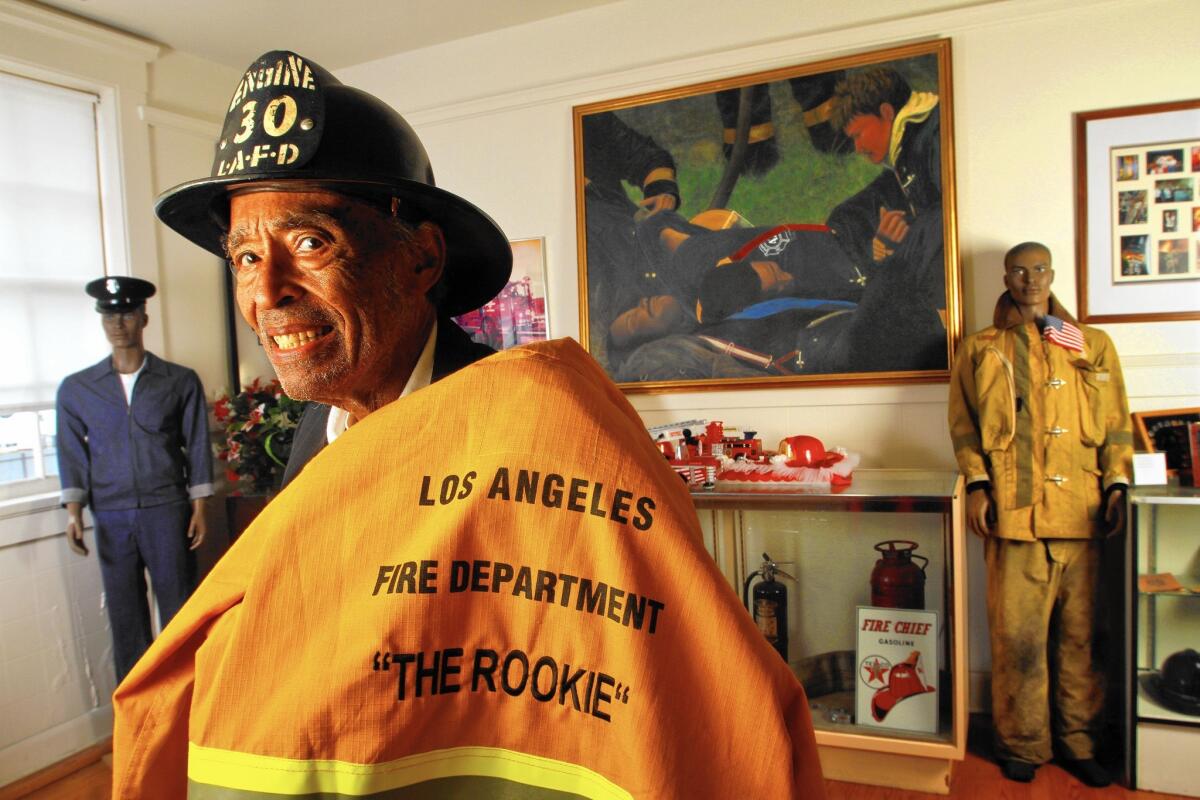Arnett Hartsfield Jr. dies at 96; helped integrate L.A. Fire Department

- Share via
Arnett Hartsfield Jr., a firefighter, lawyer and educator who helped lead the battle to integrate the Los Angeles Fire Department and became a historian of the struggle, died Friday in Los Angeles of natural causes, said his daughter Paula Johnson. He was 96.
Hartsfield was a city firefighter for 20 years before retiring from the LAFD in 1961 to practice law and teach black studies at Cal State Long Beach and other campuses.
He also was the author of “The Old Stentorians,” a history of the Fire Department’s integration, and a founder of the African American Firefighters Museum, located in the old quarters of a segregated firehouse in South Los Angeles where he was stationed in the 1940s and early ‘50s.
In 1955, Hartsfield had been a firefighter for 15 years — and had just passed the bar — when the Los Angeles Fire Department was ordered to desegregate its stations.
As one of 80 black firefighters sent to all-white stations, he was about to find out how difficult the change would be.
“The captain met me at the door and gave me a direct order never to enter the kitchen when the white firemen were eating, to use my own pots and pans and to shower only when no whites were using the washroom,” Hartsfield recalled decades later in The Times. “I was already an attorney, and every day I came to work and scrubbed toilets.”
Although infuriated by the discrimination, Hartsfield decided it was better to stick with the job and blaze a trail for others.
“He was the leader during the fight for integration,” said Brent Burton, a Los Angeles County Fire Department captain and past president of the black firefighters group the Stentorians, which Hartsfield helped organize. “It made him the subject of much scrutiny, but after all he endured he was still positive.”
Hartsfield was born in Bellingham, Wash., on June 14, 1918. He grew up in an interracial family as the grandson of a white Irish Canadian and a black woman who had left slavery. The only black people he knew growing up were his relatives.
Until his family moved to California in 1929, “I never had a black neighbor or a colored kid in my class. I had no racial hostility at all,” he recalled in a 2009 interview for the California Firefighters History Project.
He graduated from Manual Arts High School in South Los Angeles and worked in construction before joining the city Fire Department in 1940. He was on duty at Station 30, one of the city’s two all-black stations, when Pearl Harbor was bombed in 1941. Because he had been in the ROTC, he was commissioned as an Army infantry lieutenant but served in a segregated unit.
After the war, he returned to the segregated department and attended law school at USC on the GI Bill.
He chafed under the department’s discriminatory system. Before 1955, all black firefighters worked in either Station 30 or Station 14, both on Central Avenue. With only two black stations, the number of black firefighters was basically capped. Promotions were also severely restricted: A black firefighter could move up only when a black captain retired or died.
“Back then … I was bitterly complaining all the time,” Hartsfield told The Times in 2005. “As long as I was busy complaining, all I saw was the dark side: I can’t promote. During the ugly integration fight, I was known to the chief and the white firemen as the ‘damn [black] agitator.’”
Bolstered by Brown vs. Board of Education, the landmark 1954 U.S. Supreme Court decision against school segregation, he and about 30 other black firefighters formed the Stentorians — a Greek term for those who speak out — that year.
The following year, Hartsfield and 80 other black firefighters were reassigned — but only one per white station. “They called it integration. I called it isolation,” Hartsfield said.
Although some white firefighters were friendly, most greeted the black firemen with hostility, forcing them to perform rookie work — laying hoses, cleaning poles — despite years on the job.
One black firefighter found feces smeared on his pillow. Most of the black firefighters could not keep their food in the same refrigerator as their white co-workers. If they did, Hartsfield said, “white firefighters opposed to integration would urinate” on it.
At his integrated station, Hartsfield did not experience any problems with his food, but he ate alone for six years. And he said that though he “never heard the N-word,” whites called him Calhoun, after the shady lawyer character in the popular 1950s black sitcom “Amos ‘n’ Andy.”
He kept a record of the injustices and turned the material into “The Old Stentorians,” co-written with Billy Mills and published in 1973.
As a lawyer, Hartsfield often represented clients for free. “He couldn’t make a living doing that,” his daughter said, and he turned to teaching. He taught for 26 years, retiring in 1988 when he was 70.
In addition to his daughter Paula, Hartsfield is survived by his second wife, Jeanne Hartsfield, of Inglewood; daughters Charlean Fields of Los Angeles and Barbara Heyward of Seymour, Tenn.; son Arnett Hartsfield III of Bakersfield; three grandchildren; two great-grandchildren; and two great-great-grandchildren.
In 2010, he received the Fire Department’s first Lifetime Achievement Award, presented by Douglas Barry, the department’s first African American chief.
The discrimination Hartsfield and others experienced might have been easier to swallow “if I could have looked forward to today and all the advances” that have been made, he said some years ago. “I didn’t dare to hope that it would change during my lifetime.”
Twitter: @ewooLATimes
More to Read
Start your day right
Sign up for Essential California for the L.A. Times biggest news, features and recommendations in your inbox six days a week.
You may occasionally receive promotional content from the Los Angeles Times.






